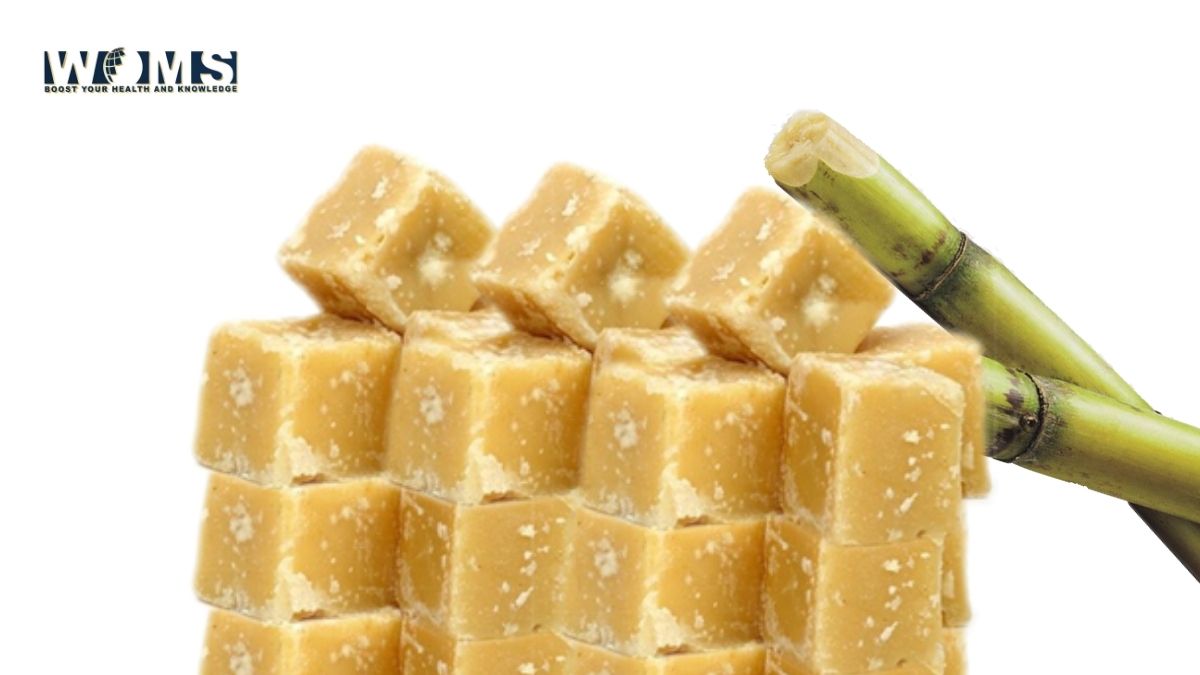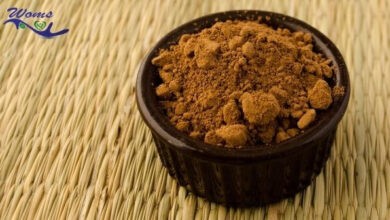Jaggery Nutrition Profile and Health Benefits

What is Jaggery?
In South and Southeast Asia, jaggery is widely used as sugar. Jaggery is a rich, brown sugar-like substance that has sweetness less than maple syrup, is little viscous than honey, and whose flavor is rich as brown sugar. It has a taste that forms when molasses and buttery caramel are in a mix. While seeing Jaggery nutrition we can see it is very nutritional.
The sap of the palm trees is the sole source of Jaggery due to which it is so uncommon in the United States. The tropical condition is a must for the growth of Palm trees due to which the majority of the United States are into exclusion.
Palm trees of different types are present and jaggery can be made from these different types of jaggery plant-like date palms, coconut palms, or sago palms.
Today palm plants make jaggery in Myanmar. From the trees the sugar is tapped and, like maple syrup, can be boiled down to be utilized in a variety of ways.
Types of Jaggery
Jaggery, often called ‘gud’ or ‘gur‘ is a popular winter snack. Here’s a rundown of the several forms of jaggery, its uses, and how to tell if it’s pure.
1. Sugarcane Based Jaggery
Sugarcane jaggery forms from sugarcane juice that undergoes processes like boiling, filtering, and churning using conventional processes. It’s one of the most popular kinds of jaggery.
One method to tell if it’s pure is that it’s light to dark brown in color and hard to bite. The darker the jaggery, the better; light-colored jaggery indicates adulteration.
2. Palm Based Jaggery
The sap from palm trees makes palm jaggery. Sugarcane jaggery is also undergoing the same process of heating, filtering, and churning in the same way. This variety of jaggery is dark brown in color and has a “melt in your mouth” quality.
It is a suggestion that you try it before you buy it. This jaggery becomes saltier as it ages. Furthermore, if it tastes harsh, extremely sweet, or contains crystals, it was caramelized or artificial sweeteners were used.
3. Coconut Jaggery
Unfermented coconut sap makes this form of jaggery. It is sugar-free and high in iron and magnesium, both of which are necessary nutrients for your health. It’s an important feature of Goan cuisine, and it is present in a variety of gravy recipes.
It has the darkest color and the hardest texture of all the varieties. One approach to check for purity is to dissolve a slight amount of jaggery in a bowl of water. If it contains contamination then the particles will separate and sink to the bottom.
Benefits of Jaggery Nutrition
The assumption that jaggery is more healthful than refined white sugar is one reason for its growing popularity. It has a number of health benefits. Let’s see the benefits of jaggery.
Better digestive health, anemia prevention, liver purification, and improved immunological function are all typical health claims.
Here’s a look at the most prevalent health claims and how to tell the truth from the fiction. Jaggery has therapeutic benefits in addition to being delicious. It is in for the treatment of various respiratory infections in Ayurvedic medicine, according to The Washington Post.
Unrefined sugar preserves more vitamins and minerals than refined white sugar. Aside from the alleged health benefits, the mildly spicy, rich flavor of jaggery is enough to entice us to seek this Asian gem.
There is a lot of nutrition while seeing jaggery nutrition which makes it healthy to consume.
1. Enhanced Digestive Health
Jaggery is commonly taken after a meal. It may aid digestion and if you are more prolonged to constipation then you should take it cause it will help you because it encourages bowel movements in people.
Although jaggery is high in sugar, it is low in fiber and water, both of which aids with regular bowel motions. There is no evidence to back up this assertion. Jaggery does not appear to aid digestion or avoid constipation, based on the nutritional profile.
2. Prevention of Anemia
According to several types of research, the iron in non-centrifugal sugars is easier for the body to absorb than iron from other plant sources. Iron content in jaggery is roughly 11 mg per 100 g or around 61 percent of the RDI.
Although this seems great, it’s unlikely that you’d consume 100 g of jaggery in a single session.
A tablespoon or teaspoon is a more realistic serving size. A tablespoon (20 grams) of iron contains 2.2 mg or roughly 12% of the RDI. A teaspoon (7 grams) of iron contains 0.77 mg or roughly 4% of the RDI.
When used to replace white sugar, jaggery can provide a little quantity of iron to persons who have a poor iron intake. This list of 11 iron-rich foods, on the other hand, will provide significantly more iron.
Added sugar is also harmful to your health. As a result, recommending that you eat more jaggery because it includes iron is unjustifiable.
3. Beneficial for Liver Detoxification
Many foods claim to aid in the elimination of toxins by the liver. Your body, on the other hand, is capable of eliminating these toxins on its own.
There is no proof that any meal or drink may make the “detox” process go faster or easier.
4. Immune Function Health
Jaggery is present in tonics to cure a range of diseases. The minerals and antioxidants in jaggery enhance the immune system and aid recovery from illnesses such as the common cold and flu.
Oral zinc and vitamin C supplements can lessen the length and severity of a cold, but neither is present in large concentrations in jiggers.
Overall, there isn’t enough data to back up this claim. The high-calorie content of jaggery, on the other hand, may assist improve energy levels in those who are unable to eat due to illness.
How to Make Jaggery?
Sugar cane juice can also make jaggery. Sugar canes are crush to extract cane juice then the liquid undergoes the cooking and is reduce down to generate jaggery. ( Boiling sugar cane also makes molasses.)
Jaggery is sometimes labeling into by types, such as whether it is from palm trees or sugar cane, but this isn’t always the case. Because jaggery does not require “expensive refining,” The boiling and reduced liquid, whether it comes from palm tree sap or sugar cane juice, is merely the beginning for a variety of goods.
Jaggery in different countries
The syrup is cool down and cuts into sweets, or it can be blend with almonds or coconut. In Myanmar, jaggery candies are commonly eaten by themselves, or the sticky syrup is rolled into small balls with tamarind and then coated in sugar.
Jaggery is a type of unrefined sugar that is present in Asia and Africa. It’s sometimes called a “non-centrifugal sugar” because the beneficial molasses isn’t removed during processing. Similar non-centrifugal sugar products can be found in Asia, Latin America, and the Caribbean under various names.
These products include Gur: India, Panela: Colombia, Piloncillo: Mexico, Tapa dulce: Costa Rica, Namtan tanode: Thailand, Gula Melaka: Malaysia, and Kokuto: Japan.
About 70% of the world’s jaggery comes from India, where it is as “gur.”Sugar cane is the most common ingredient. Jaggery from the date palm, on the other hand, is widely in use in a number of nations.
Jaggery Vs Sugar
You’ll receive a few more nutrients if you use jaggery instead of white sugar. In this regard, it’s a better option. However, rather than relying on your favorite sweetener for nutrients, you should try to get them from the foods you eat.
Jaggery is still sugar at the end of the day and should be in use sparingly. Because of the molasses content, jaggery contains more nutrients than refined sugar.

Molasses is a healthy by-product of the sugar-making process that is typically removed when refined sugar is made. The addition of molasses to the finished product provides a tiny amount of micronutrients.
Jaggery Nutrition Profile
It is true that Jaggery is Nutritional so let’s see the jaggery nutrition profile.
Depending on the species of plant used to create it, the nutritional profile of this sweetener can vary (cane or palm). 100 g (half a cup) of jaggery may contain the following ingredients, according to one source:
- Calories: 383
- Protein: 0.4 g
- Fructose and glucose: 10–15 g
- Sucrose: 65–85 g
- Fat: 0.1 g
- Magnesium: 70-90 mg, or about 20% of the RDI
- Iron: 11 mg, or 61% of the RDI
- Manganese: 0.2–0.5 mg, or 10–20% of the RDI
- Potassium: 1050 mg, or 30% of the RDI
Keep in mind that this is a 100-gram (3.5-oz) amount, which is significantly more than you’d normally consume in one sitting. You’d probably eat about a tablespoon (20 g) or a teaspoon of it (7 g). This jaggery nutrition profile will help you in many ways.
mall levels of B vitamins and minerals, such as calcium, zinc, phosphorus, and copper, may be present in jaggery.
SugaVida, which is a granulated form of palm jaggery that is believed to be a rich source of naturally occurring B vitamins, is one commercially accessible product.
Jaggery Nutrition uses
Jaggery contains sugar-like elements so it can be in use in various ways. It can be broken into small pieces and can be used in place of refined sugar in meals or beverages.
It is in use mostly with ingredients like coconuts, peanuts, and condensed milk to make traditional treats and candies.
Some examples of using jaggery are while making Jaggery cake and Sakkara Pongal, a rice and milk dish. It’s also in use to manufacture traditional alcoholic beverages like palm wine, as well as for non-food reasons like fabric dyeing.
This sweetness of jaggery is commonly in use as an alternative to sugar in baking in the Western world. It’s also good for sweetening beverages like coffee and tea.
Jaggery Nutrition Disadvantages
Although there are many advantages disadvantages are also present. Let’s see the jaggery disadvantages.
Excess sugar consumption is linked to a number of the world’s most common chronic disorders. When excess sugar consumption is taken then it may cause diseases like obesity, heart disease, and type 2 diabetes, according to research.
Jaggery is still sugar, despite its slightly different nutritional profile. As a result, consuming too much of it is not recommended.
Jaggery Tea
The most common beverage is chai, or tea, with most people beginning their day with a hot cup of tea. Tea use, on the other hand, should be limited because it contains sugar, which can contribute to a variety of chronic conditions, including type 2 diabetes.
As a result, chai drinkers are moving to organic jaggery tea instead of sugar tea.
Jaggery is good for digestion, especially if you have constipation. After a lengthy period of fasting, a morning tea brewed with jaggery is great since it aids digestion. Iron, which is a crucial component of hemoglobin, is abundant in jaggery.
It keeps the body warm throughout the winter, cures coughs, colds, and allergies, is high in antioxidants, helps with digestion, combats anemia, and boosts immunity.
How to Make Jaggery Tea?
Tea lovers should be curious about How to make jaggery tea so let’s see how to make jaggery tea.
As the water begins to gently simmer, put in the tea leaves. Reduce the heat to low and cover the saucepan.
Add the grated jaggery to the tea after 30 seconds and stir quickly. To ensure that jaggery dissolves rapidly in tea, make sure it is grated (avoid lumps).
Jaggery Tea for Weight Loss
Jaggery, if consumed in a sufficient and controlled amount, may aid weight loss. One of the advantages of jaggery tea is that it supports a healthy metabolism that allows food to be digested quickly.
It contains no trans-fats or other types of fat. Weight gain is caused by trans-fats. As a result, jaggery aids weight loss, particularly in the abdominal area. This is all about the jaggery nutrition profile.
FAQs
When and how much jaggery to eat every day?
Take a little piece of jaggery, around 10-15 grams, and cut it into small pieces. Consume it on a daily basis with food in any form. It helps to activate the digestive enzymes in our bodies, which aids inappropriate food digestion. As a result, many people choose to eat jaggery as a dessert after a meal. It functions as a detox because it aids in the cleansing of the liver by removing harmful toxins from the body.
Is jaggery better than sugar?
Sugarcane juice is used to make both sugar and jaggery. They are, however, processed in a different way. To make sugar, sugar syrup is processed with charcoal to give it a clear appearance. Sugar is left with simply plain sucrose at the end of the industrial process. Jaggery, on the other hand, does not go through this procedure. It is unquestionably less processed, and hence has a higher nutritional value than sugar.
Sugar is renowned for having ’empty calories,’ or calories that have no nutritious benefit. Jaggery, on the other hand, is known for its wide range of health advantages due to its high nutritional value. It has been discovered that eating jaggery after a meal aids digestion. It also aids in the removal of toxins from the body and the relaxation of respiratory muscles.
Is jaggery good for diabetes?
Organic jaggery does not elicit the same “extent of human response in the body” as white sugar. Jaggery contains a lot of sugar, yet it’s less risky for diabetics than white sugar. According to a review published in the International Journal of Agricultural Science, jaggery also contains iron, phosphates, and calcium, which are not found in white sugar. Jaggery had higher moisture content and lower sugar content than white sugar, according to a study published in the Journal of Food Science and Technology. When compared to the commonly used white sugar, jaggery is better for diabetics.




